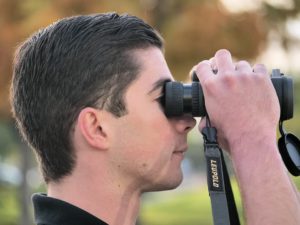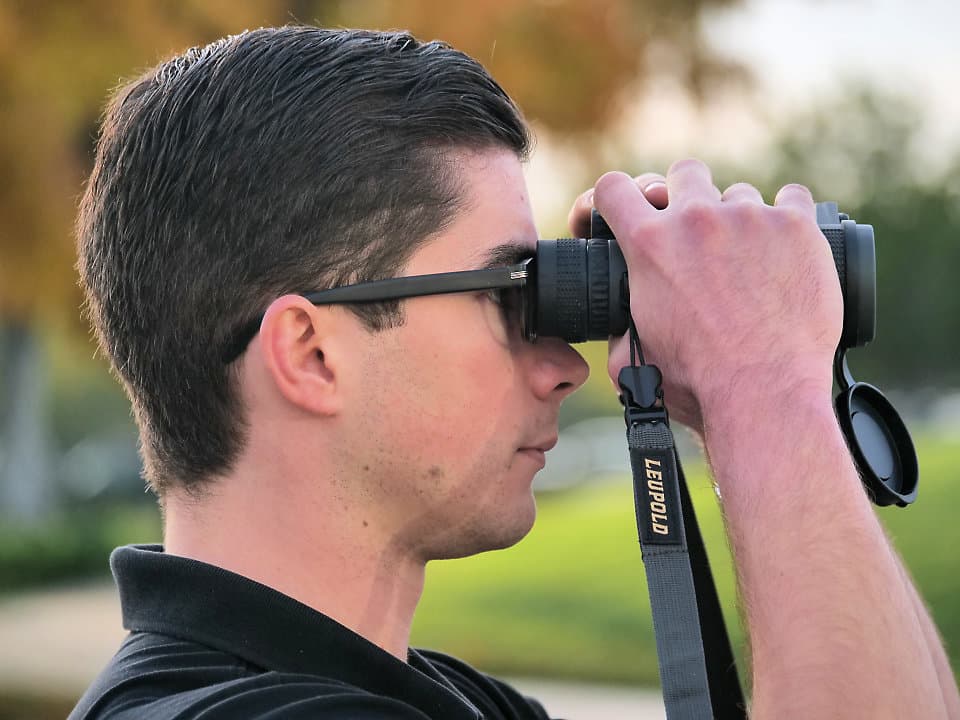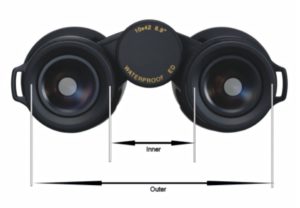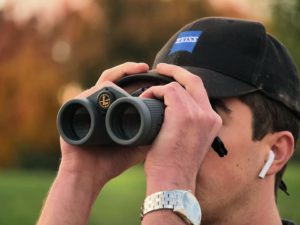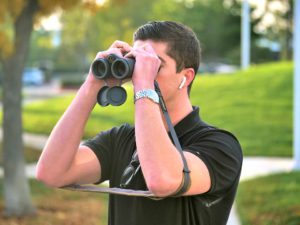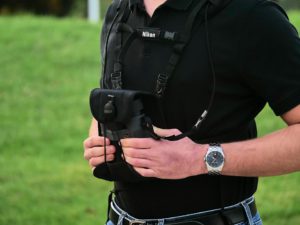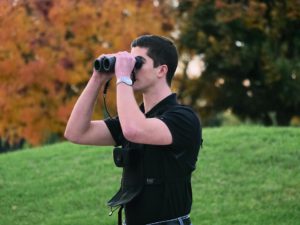In this article, we’ll be covering best practices for using binoculars. Every birder has binoculars, but not every birder knows or understands how to get the best results from them: how to set them up, how to hold them, and how to wear them for optimal performance.
Using Binoculars: Setting up your binoculars
The first step in binocular setup is the initial positioning of the eyecups. Most modern binoculars have eyecups on the eyepieces that adjust up and down to get your eyes the proper distance from the eyepieces. Any bird-worthy binocular will have eyecups that twist up with click stops (detents) between fully up and fully down. If you don’t wear eyeglasses while birding, even if you wear contact lenses, start with the eyecups fully extended.
Start with the eyecups all the way down if you’re wearing eyeglasses while birding. Depending on your facial structure, neither fully up nor fully down may work for you. Then, try the intermediate positions. If that fails, you might need a binocular with longer eye relief.
Interpupillary Distance
The next step is setting the interpupillary distance (IPD) to accommodate the distance between your eyes. To do this, look through the binoculars and adjust the distance between the eyepieces until you see one circle. Real binoculars don’t look like the figure 8 you see in the movies or on TV. If your eyes are very close together or very far apart, you should get your IPD measured before you buy your binoculars so you know what to look for in the binocular specification to determine whether the binocular will fit you. If you wear eyeglasses, your optometrist should know this value from your prescription. If not, you can measure your IPD using binoculars. Borrow a binocular, set them for your eyes, and make the measurements shown below, in millimeters, using the inside edges of the eyecups. Average the two measurements to get your actual IPD.
Most 42mm binoculars have a minimum IPD around 56mm, but some will get as close as 52mm. Most 42mm binoculars have a maximum IPD around 75mm, but some will get as large as 78mm. Check your requirements before buying to save time and the expense of returns and exchanges.
Once you’ve set the IPD, it is time to adjust the diopter setting. Most people have eyes that focus differently between their left and their right. Eyeglasses correct for this difference, so eyeglass wearers should be able to leave the diopter setting at 0. If you wear glasses and both eyes do not focus individually with the diopter set to 0, the diopter setting may be off. Call us for help in testing this.
Diopter Adjustment
Diopter controls can be a ring on the right eyepiece or a control on or under the focus knob. In either location, there may be a mechanism that allows the control to lock in place, so it doesn’t change accidentally. Locate your diopter control and determine how it operates. Non-locking diopter controls will be very stiff. You may need to use a fair amount of force to move it.
Set the diopter to its neutral position. Close your right eye or cover the right objective lens and use the focus wheel to focus the binocular for your left eye. It is always best to focus on some text on a flat surface so you can tell when the focus is perfect. Then, without moving your feet or your posture, close your left eye or cover the left objective and focus for your right eye using the diopter control. Set the diopter lock if you have one or notice the position of the dial so you know how to reset it if it moves.
Using Binoculars: Holding Them for Maximum Stability

Supporting the binoculars on balls of the thumbs and heels of the palms
Holding your binoculars steady is critical to spotting and following birds efficiently. Many birders choose lower powered binoculars because they don’t think they can keep their binoculars from jiggling. In my experience, it’s their holding technique that needs alteration. Unfortunately, binocular manufacturers compound the problem by building in thumb rests that encourage improper technique.
Most people hold binoculars with their elbows out to the sides and only their thumbs underneath the barrels. This posture gives very little support as the thumbs act as fulcrums for the binoculars to teeter on. A much more solid posture is to cock your wrists so that the binocular tubes rest on the heels of the thumbs and the heels of the palms. This creates a platform that is much more stable. It also brings the elbows into your sides for two more contact points to support your arms.
Alternate holding techniques
When viewing for a long time without a tripod, there are two more helpful techniques.
In the ball cap technique, grip the binocular as described above, then hook your middle fingers over the brim of a cap or hat. This further supports your arms as they tire. The ball cap technique also works with other types of hats as long as the brim is short enough.
In the rifle sling technique, you wrap a long binocular strap or harness around your arms above the elbows and pull your elbows outward until the strap becomes taut across your chest. This technique is taught by the professionals in Nikon School as a way to hand hold long lenses when you need to be mobile.
Wearing Your Binocular for Comfort and Accessibility
Beginning birders usually wear their binoculars using the neck strap that comes with the binocular. The problem is that even with a wide neoprene neck strap, the weight of the binocular is concentrated on the back of the neck, which gets tiring after using binoculars for as little as a couple of hours in the field. These days, more and more birders are using binocular harnesses.
In most cases, a binocular harness is made of a leather patch that anchors two adjustable elastic straps between the wearer’s shoulder blades. Each strap has a plastic snap hook that slides along the strap enabling the binocular to be lifted into place. The basic harness has advantages over the neck strap in that the weight of the binocular is distributed over both shoulders rather than the back of the neck, and that it keeps the binocular closer to your body if you fall, run, or ride in a car on a bumpy road. You’re also less likely to put the binocular down and leave it somewhere.
Recently, more elaborate harnesses have been introduced. Some include a case that completely encloses the binocular, others are more open, yet still cover the binocular’s lenses, eliminating the need for objective lens covers and rainguards. Our current favorite is the Nikon Trex Exo Carry System. It is an open case style that has a hard flap above the eyepieces that keeps rain and debris from filling up the eyecups, and a flexible flap with an adjustable bungee cord latch to protect the objective lenses. This harness keeps the binocular well protected, yet ready for rapid deployment.
Using Binoculars: Conclusion
These are the tips and tricks we’ve learned over the years that make nature observation more productive and less stressful. And, since we’re never too old to learn, we invite you to share other techniques that work for you.

